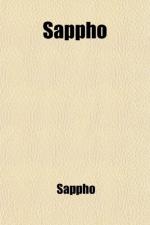|
This section contains 5,357 words (approx. 18 pages at 300 words per page) |

|
SOURCE: Zonana, Joyce. “Swinburne's Sappho: The Muse as Sister-Goddess.” Victorian Poetry 28, no. 1 (spring 1990): 39-50.
In the following essay, Zonana highlights poet Algernon Charles Swinburne's identification with Sappho and her apotheosis as the “Tenth Muse.”
In an important early poem, “Sapphics” (1:333-335),1 Swinburne introduces a theme that was to dominate both his poetry and prose: Sappho's apotheosis as the tenth Muse, a poet whose “visible song” soars as “a bird soars.” By identifying Sappho as a Muse—and ultimately, as we shall see, as the Muse, not only for him, but for all poets—Swinburne radically redefines the nature of poetic inspiration and the role of a female principle in art produced by men; by elevating a mortal woman into the place normally reserved for immortal goddesses, he expresses his special notion of the relation between humanity and divinity while simultaneously revising the inherited Christian notion of an exclusively...
|
This section contains 5,357 words (approx. 18 pages at 300 words per page) |

|


